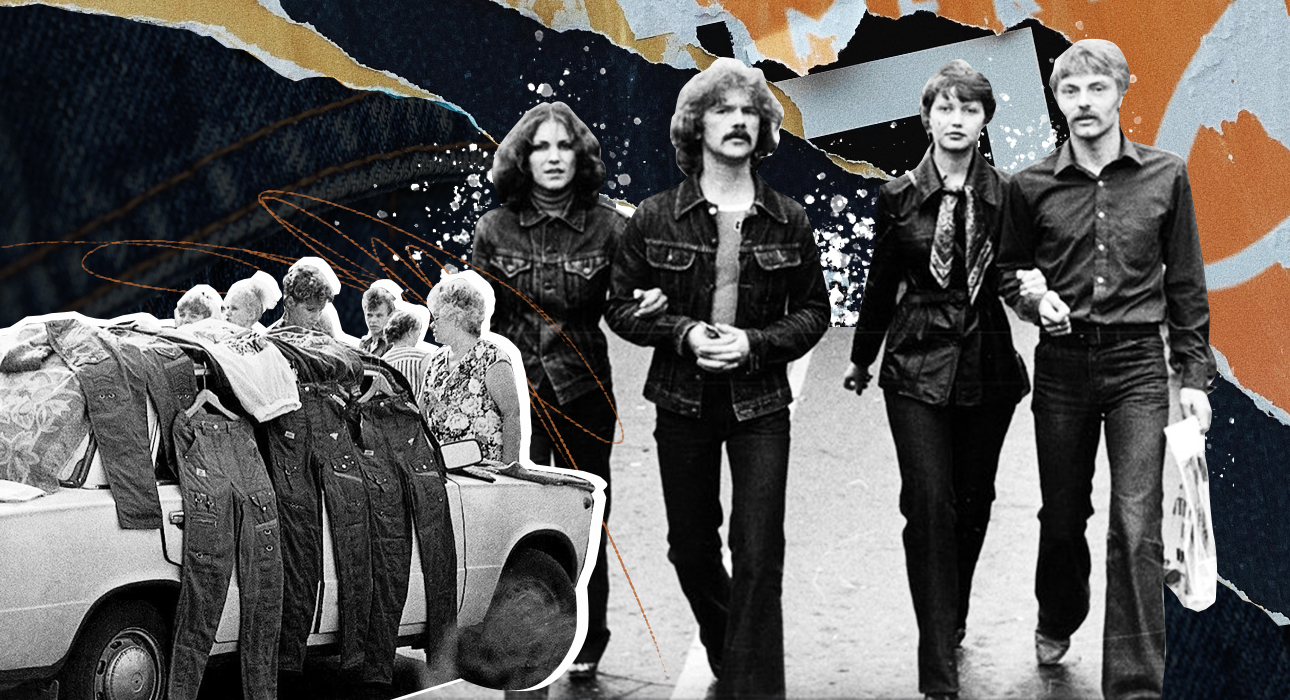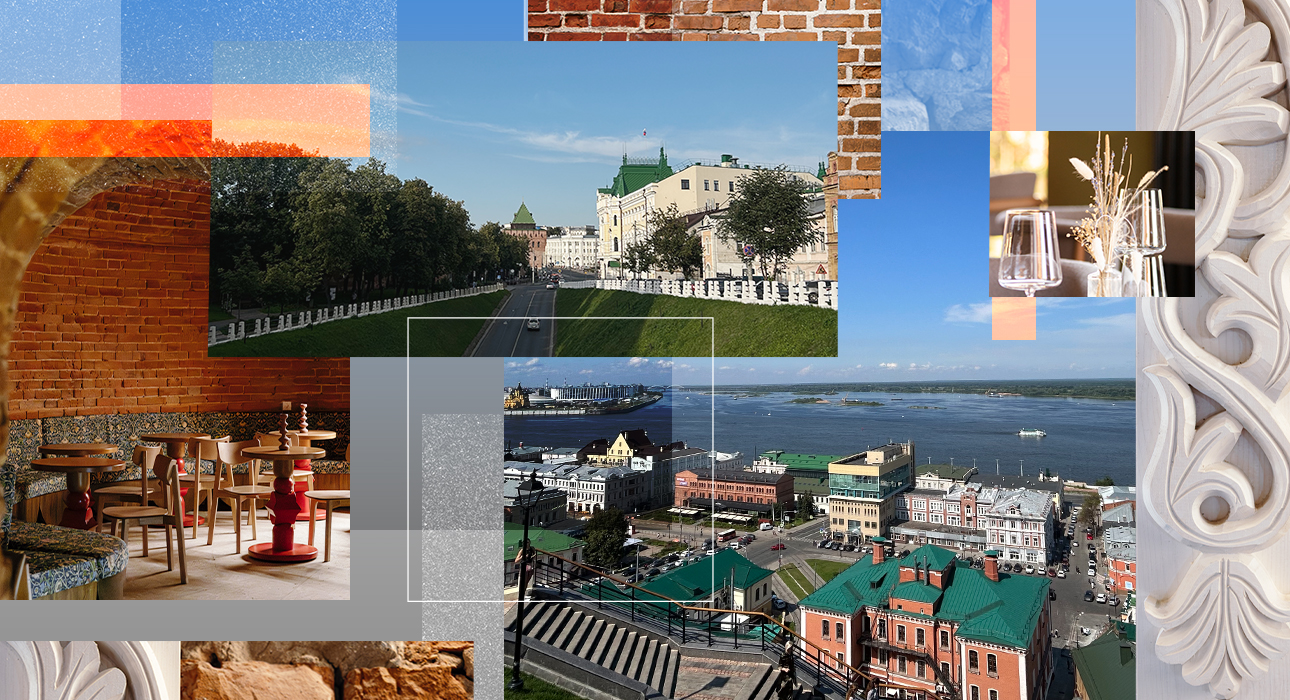In 1986, Sergei Dovlatov published a collection of short stories “Suitcase”, one of the sections of which is “Finnish Crepe Stockings”, devoted entirely to the art of fartsovka. More precisely, it is not art, but an unfortunate combination of circumstances, so that the author is out of money, but he has a hundred Finnish socks in his hands, which are not subject to sale.
In general, the image of the so-called dealers of the USSR era was often played in the literature and cinema of that period. Take, for example, the scene where the main characters from the movie “The Most Charming and Alluring” come to an acquaintance’s apartment to buy some imported goods. Or remember the painting “Diamond Hand”, where the heroine of Svetlana Svetlichnaya (also known as “It’s not my fault!”) wrote on a piece of paper the address of the hotel where Yuri Nikulin could find her mother’s jacket. -pearl buttons. And all this is not a clever invention of the directors, but the harsh reality of those who live in the USSR and want to dress stylishly.
The younger generation doesn’t understand that trying to buy ordinary jeans, sneakers and a printed T-shirt 40 years ago was equated with an “impossible” task. Due to a large household shortage, these things were not available in domestic stores, and the sale of imported things was prohibited at the legislative level, punishable by up to 15 years in prison. And no, it’s not a fantasy either. Today we invite you to go back to the 1980s and learn a little more about how our parents sought fashion items in an era of total famine.
Who are these scammers?
In simple terms, these are people who illegally buy things and money from foreigners and sell them to third parties. If we discard all unnecessary introductions, we get the most common seller where you can find rare alien things. Fartsovschiki appeared in the late 1940s and existed until the collapse of the USSR.

It was a kind of guide to the developed population, to the world of Western culture, and they could provide registration, equipment and, of course, clothing to those who wished. Jeans, sneakers, t-shirts, shirts, leather jackets and even socks were especially popular at that time. True, not everyone can afford such a luxury. For example, a denim shirt cost about 50 rubles, and the average salary was 150 rubles. So, consider for yourself how expensive the imported things are.
Where did they get the items?
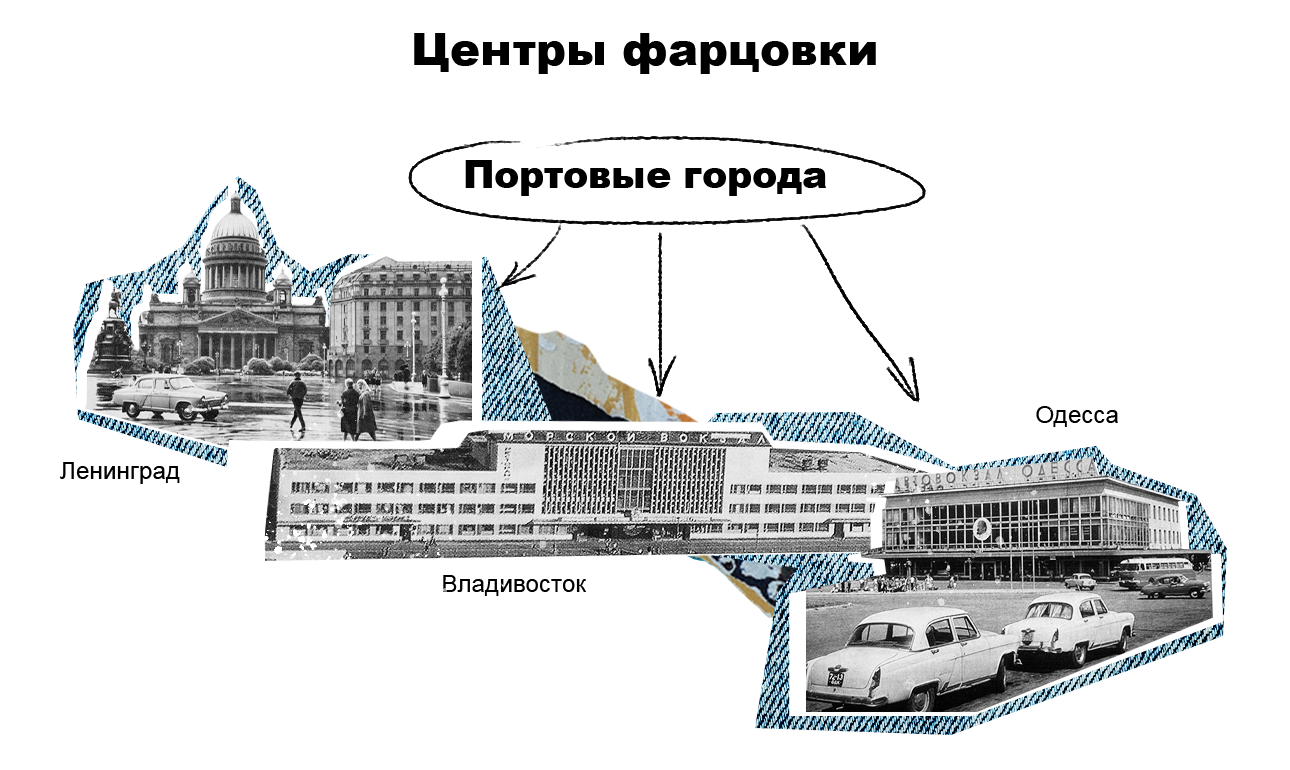
Most often, port cities such as Vladivostok, Leningrad and Odessa became centers of fartsovka, where they stopped every day to refuel a ship with cargo. Experienced merchants had their own employees there who could deliver any order. But beginners approached the sailors with a simply crafted phrase: “Let’s change.” As a result, they can swap a bottle of vodka for a shirt.
In addition, drivers of Sovtransavto and other international road carriers, who went on frequent business trips, had access to foreign currency and therefore foreign things. Most of the time, personal items are not inspected, so a box of t-shirts or jeans can be safely taken with you. Even if careful customs officers find something illegal, they can be “settled” with something imported.
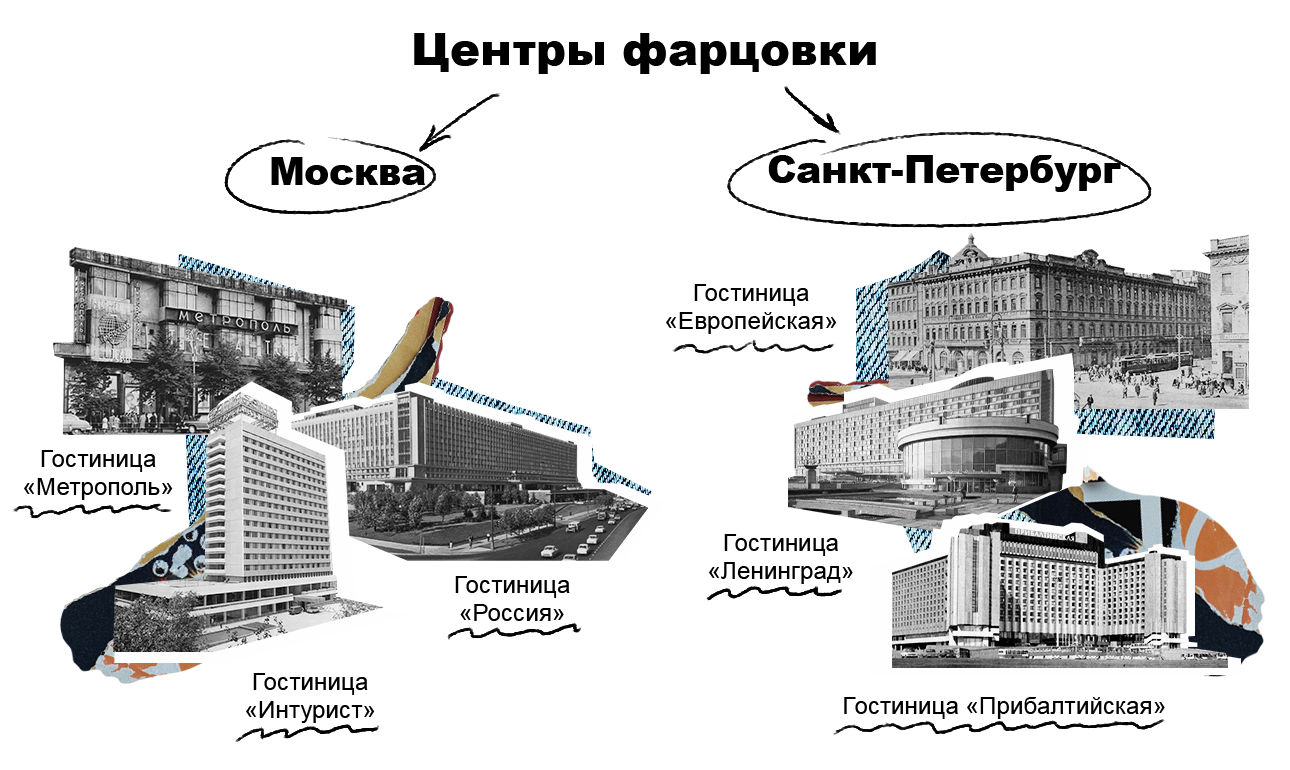
Another source of power for all black marketers was the hotels where foreigners lived. In Moscow, the Metropol, Intourist, Rossiya hotels became central attractions, and St. Petersburg – in Leningrad, Europe and Pribaltiyskaya. Citizens of the USSR were forbidden to go inside, so often scammers either caught Firmachs (firmach is the slang name for foreigners) near hotels, or went to a restaurant or lobby with the help of cheats of various levels.
Well, let’s not forget about foreign students who quite often cooperate with black traders and have access to Beryozka. For those who don’t know what it is, we explain it. “Beryozka” – a store for foreigners and diplomats, where you can buy any scarce product for currency. For example, Japanese TV, Italian boots, American jeans, etc. Despite the fact that prices in Beryozka were greatly inflated, the goods were still in demand.

Later, it was allowed to buy things in large stores not only for foreign currency, but also for special checks from Vneshposyltorg. Their denominations ranged from a penny to a hundred rubles. It was given in exchange for currency earned by Soviet specialists abroad. Thus, the state received an additional source of valuable money, and its owners – access to scarce goods.
True, here were scammers who exchanged rubles for fake checks. And the beauty is that the victim could not do anything because he himself was engaged in illegal activities.
What can be bought from Fartsovshchikov?
Almost everything: from chewing gum and badges to jackets and hats. Farts can find the brands Patagonia, Columbia, The North Face, Eddie Bauer, and Jansport.
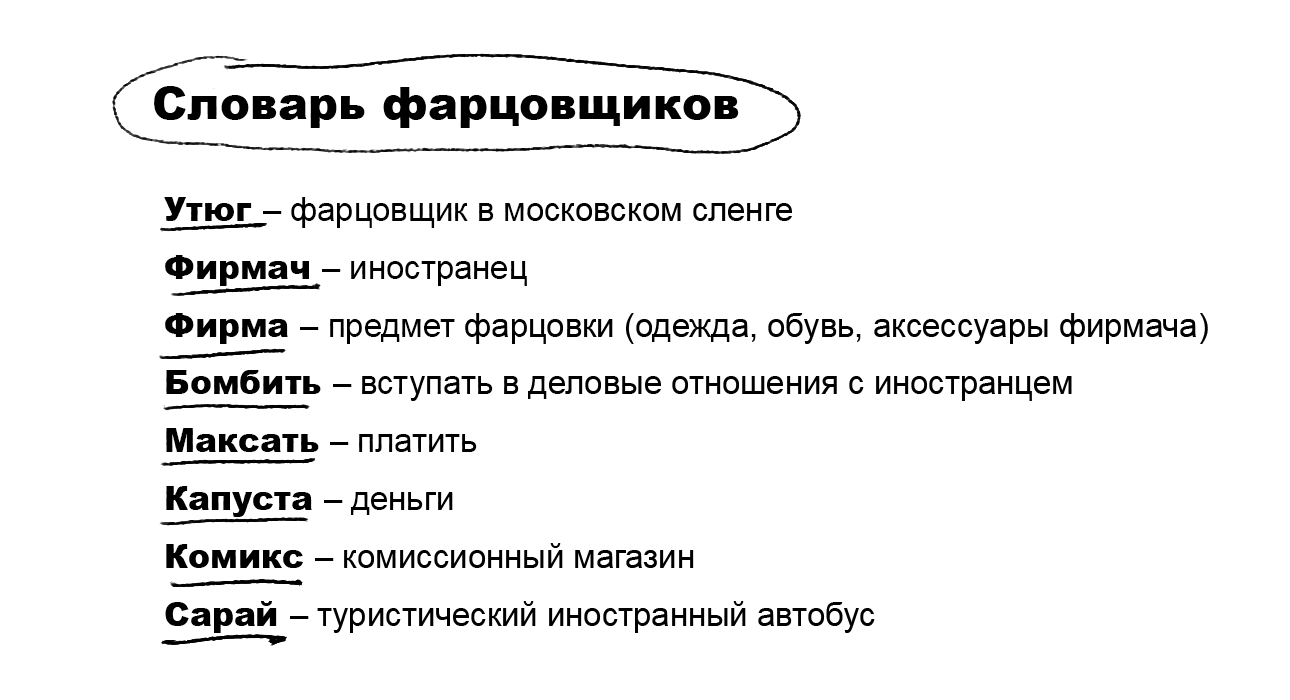
However, the most desired item was again jeans. And it’s not simple, it’s branded. Advanced youth dreamed of a couple Levi’s 501, Lee and Mustang. Jeans were so envied that in Soviet youth the phrase “We may not remember our first kiss, but it is impossible to forget our first jeans” and jokes such as “Come to my house in ripped Levi Strauss jeans” entered folklore. and “We bought Lee jeans for the girls to love us.” True, a pair of jeans costs 120-180 rubles for a moment. We remind you that the average salary is 150 rubles.
What about those who don’t have money?
Soviet youth have always been distinguished by their special ingenuity. For example, some cut jeans, made patterns and created similar pairs from cheaper materials. Such jeans wore out very quickly and the reference looked completely different from Levi’s. But even here there were some experiments. To give the pair a beautifully worn look, the jeans were first boiled in boiling water with the addition of bleach or bleach and then rubbed in parts with ordinary pumice.

You can also go to a second hand store. Theoretically, only second-hand items were sold there, but in reality about a quarter of the store was new items brought in by black marketers. This, of course, was illegal, but as a rule, no one controlled such moments. Therefore, many came to the store and bought jeans, shirts, socks, tights and even panties absolutely legally. True, not American, but Czechoslovak or Riga. But things from neighboring countries were much cheaper.
True stories of “treasure hunters”
We solved the theory, now we move on to practice. For our material, we have collected four stories of real people who caught the fartsov era and felt the shortage of households for themselves. So today you will learn how to wash jeans, go to apartments for things, how to bring AC / DC t-shirts from abroad and how to confront scammers.
Igor C.

In the late 1980’s I had a dream, to buy a brand new Panasonic TV with a plastic case and most importantly a remote control. It was possible to buy it only in the Beryozka store. And not for ordinary money, but for special checks. I had to buy them from fartsovschikov. The amount was quite large – five thousand rubles (that is, a thousand checks), so I decided not to risk it and arranged a meeting with the two men at my house. In the evening they came, we went to the apartment together. These two brought in a lot of checks and let me count, I did the same with rubles. Then I realize that ten checks are missing and I say, “There’s a problem here.” One of them counted again and said everything was fine. I picked up the deck again and started counting the checks. Again not enough. Then the man said he would just add 10 more bills, took the package from me and counted the agreed checks to him. All this happened before my eyes. Then they asked me to go out with them – they said they were afraid that I would call the police. I usually went downstairs, said goodbye to them, then came back and started counting the money. And what do you think? I was deceived On the top and bottom of the package there were checks with a face value of 100 rubles, and everything was one by one inside … So with this money I bought a pair of jeans and a shirt instead of a brand new TV. . At first I was very angry with myself, but then I realized that everything done was for the best. It was thanks to these jeans that I met my future wife a few months later. He came up to me in one of the apartments and asked: “Where did you get this?” I was no longer thinking about television.
Dimitri M.
In 1985 I flew to Moscow to enter the institute. Later, the USSR provided free education opportunities to students from developing countries, including Cyprus. I had absolutely normal clothes with me – Nike sneakers, T-shirts with AC / DC and Iron Maiden prints, a denim jacket with a badge and, of course, the jeans themselves. True, exactly before I came to the Soviet Union it seemed ordinary to me. To be honest, in the early days, I felt like a celebrity because I had never been approached by so many people on the street. Everyone was only interested in one thing – whether I was selling something. And then I realized that I would not be a poor student. When I got back to Cyprus, I bought a pack of T-shirts, jeans, a few jackets and three more two-cassette tapes. I spent a lot of money, but I knew everything would work.

I wore two jeans and three T-shirts, fearing border controls. The same was done by my friends, with whom we went to study in Moscow. As a result, we sold everything in a week and earned about 6 thousand rubles. With that money, we bought a refrigerator, a stove, new beds, a sofa, and lived another year without depriving ourselves of anything. And when I fly to Cyprus I always take small orders and make good money from it.

Elena K.
The first imported item appeared in my wardrobe in 1983. Then my sister and I went to Odessa to visit our aunt in the summer. Her husband was a naval officer, so access to all foreign benefits was free. I remember how we went to the house of his friend, where “Fortune” was kept.

Of course I had no money to buy anything. In 1983, I was 18 years old and unlike my sister, I had not yet made any money. But apparently I really liked the man in charge of this case. And when we broke up, he gave me a sharp-collared shirt and invited me on a date. I accepted the gift, but declined a date a few days later. We never saw him again, but the beige shirt still stands somewhere in the country and reminds us of how we lived in the 1980s.
Galina K.
Like all my peers, I dreamed of Levi’s jeans, but from the word “totally” there was no money for such luxury. Therefore, I hinted to my young man in every possible way that I wanted just that for my birthday. And so day X came and I got my favorite jeans as a gift! That’s right, not Levi’s, but some local ones. They were dark blue and horribly cut. But I wasn’t going to give up so quickly.

First, my mom and I started modifying them to fit my body. It turned out very well. The next step was to work on the color. Then my friend and I started boiling the jeans to get a nice blue hue. Well, without friction on the knees and back pockets. We used a regular pumice stone for this. Turley is tall and very confident. The result was luxurious jeans that I wore for a few more years.
instead of output
All these wonderful stories from the past were never told to your parents to make you sad and think about how badly they lived. It was a completely different time, different rules and other laws. And happiness, as a rule, was not measured by the amount of material goods and imported things. But if they got into the wardrobe, they were carefully looked after, protected in every possible way and dressed for glory. And this attitude of the younger generation to events is definitely worth learning about.
Source: People Talk
Elizabeth Cabrera is an author and journalist who writes for The Fashion Vibes. With a talent for staying up-to-date on the latest news and trends, Elizabeth is dedicated to delivering informative and engaging articles that keep readers informed on the latest developments.

